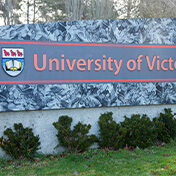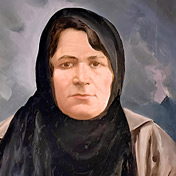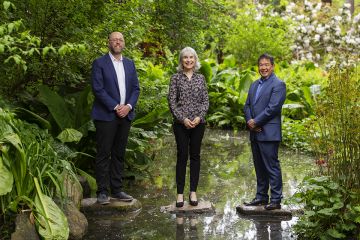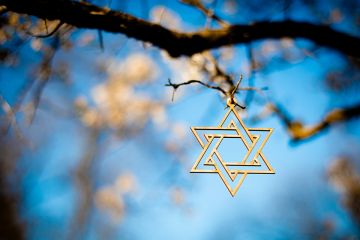Bearing witness—UVic’s Holocaust field school
- Tara Sharpe

A dozen participants of UVic’s second annual I-witness Holocaust field school project are now eyewitnesses to the sights, memories and history of the Holocaust.
One of the participants is UVic alumna Dawn Smith (Nuu-chah-nulth from Ehattesaht; Coast Salish from Tsawout).
The first of its kind at a Canadian university
The field school was launched last year—the first of its kind at a Canadian university—to explore how the Holocaust is memorialized in Central Europe and to encourage a deeper understanding of antisemitism, racism, religious intolerance, homophobia and the stigmatization of those with mental and physical disabilities.
On May 14, the I-witness group arrived in Europe after a week of classes at UVic. This year’s itinerary included stops in Berlin and Osnabruck (Germany); Krakow, Oswiecim, and Warsaw (Poland); and Prague and Terezin (Czech Republic).
In addition to visits to museums and memorials as well as the former Sachsenhausen, Auschwitz-Birkenau, Plaszow, Theresienstadt and Bergen-Belsen concentration camps, the group’s schedule included a visit with an American Rabbi in Warsaw and with a noted writer and child survivor in Prague, a Jewish musical performance in Berlin and a seminar in Prague with a psychotherapist working with second- and third-generation Holocaust survivors.
'I went outside of my culture'
“Growing up in poverty and neglect, I related to the survival aspect of it,” says Smith, MA (Indigenous Governance), a sessional instructor in UVic Indigenous Education who is now pursuing a doctor of education degree at UBC. Here in Canada, “we are so far from reconciliation and won’t even acknowledge the violence and the things that have occurred here, so how can we memorialize it when there’s no acknowledgement of it?”
“I went outside of my culture,” she adds. “The idea of going to a place where there were no Indigenous people scared me.”
She also draws parallels between an apparent lack of knowledge about Holocaust and Indigenous histories: “The Diary of Anne Frank was my exposure to the Holocaust, just like when my undergraduate students say ‘making a button blanket in Grade 5 or learning about Louis Riel was my only exposure to [Indigenous history in school].’”
Smith is currently reading biographer John Toland’s Adolf Hitler and how Hitler was influenced by treatment of North American Indigenous people: “the mass graves, internment camps, starvation, pitting people against each other, having them work as slave labour.”
Sage, tobacco and an oyster shell
She brought sage from Montana and an oyster shell from her father’s beach, as well as tobacco, to perform a ceremony before going to Auschwitz-Birkenau. “Some of the students joined me and we called on all the ancestors, not just mine.”
This year, the group also shared a class with local students in Krakow and Osnabruck. Dr. Wassilis Kassis of the University of Osnabruck, who organized the joint class in Germany, says it was his summer-term highlight: “The reciprocal and fruitful exchange between students from Germany and Canada contributed to our understanding of the lasting effects of the Holocaust and modern antisemitism.”
The field school was co-founded by Dr. Helga Thorson (Germanic and Slavic studies) and UVic MA student Michael Gans, and organized this year by Dr. Charlotte Schallié; (Germanic and Slavic studies) with travel assistance from MA student Ryan Severyn. The 12 participants included four visiting university students from UBC, Calgary, Saskatchewan and Regina.
In August 2012, the students will share their experiences at a special exhibit on the UVic campus.
Find out more
View the I-witness field notes and photographic essay from Europe, and links to last year’s coverage: ring.uvic.ca/news/student-i-witness-2012-holocaust-field-school
I-witness website and student blog: www.uvic.ca/iwitness
Photos






In this story
Keywords: Holocaust, field schools
People: Dawn Smith




